- Target Audience Map
- Brand Positioning Map
- Tone of Voice Map
- Conclusions
- Mission
- Values
- Brand character
- Core message
- Benefits
- Reasons to believe




In the Autumn of 2021, after a second professional burnout, I decided that it was time to move further and extend my professional areas. In parallel, I started working on the strategic base for my personal brand because I believed that that work would lead me to a relevant job offer and successful immigration.
In February 2022, Russia invaded Ukraine. Our immigration plan paused again. We finally left the country several months later, protesting Putin's regime and aggression toward the neighboring country. Living in Kazakhstan, I continued my personal brand strategy development and implementation. I documented every step to share my approach and experience with those who will build their personal brand. At the end of 2022, I launched my website's main page and started to upload my case studies.
I decided to share my experience with all people who want to create a solid personal brand strategy. So, I made this page where I collect all the information separated by chapters. Hope it will be useful for you, fellows!


The most challenging part was connected to a visual identity part because I had never done something like that before. After successfully implementing the Agate brand strategy and flexible visual identity, I gained more confidence, but it still was very complicated.
Also, it took a lot of work to stay focused on the big goal to which I was breaking through all global and local problems. But the way I’m wired, the more complex the challenge, the more I push and push. That was always my strength: to go against the grain, to see the big picture, to keep moving despite anything, and not to sweat the small stuff.
Every person has something significant, and it is crucial to stick to your path. That is why I pay so much attention to the self-exploring stage during personal brand building. I see no sense in starting your brand from the promotion part by posting anything just because you need to do anything. That is a very tactical way of thinking, and I propose that you look at the process differently. Let me show my vision.


So many courses offer people the ability to build a personal brand, but most suggest doing it on the tactical level. What do I mean by talking about the tactical level? Personal and other brands (consumer, employer, geographical, etc.) are integral to marketing. Because I have a strategic marketing background, I can simplify as much as possible and tell what marketing is about. It's about two sub-activities: creating a product and promoting a product.
Creating a product is a strategic-level activity. At that stage, we, marketing professionals, research markets and competitors. We dive into target audience segments to understand their needs to create products that will meet and even anticipate their demands. Then we create a brand positioning, messages, and identities to be understandable for people. We develop go-to-market plans and set specific communication channels relevant to our target audience. And only after that do we step into the next stage.
Promoting a product is a tactical-level activity. At that stage, we use a specific set of channels suitable to advertise our products. For example, if we're talking about social media, we hire a team to manage it professionally. At least we need a social media strategist, copywriter, designer, and targeting professional to implement our marketing and brand strategies. Without such input data as brand positioning, brand character, and brand benefits, hiring such a team is hazardous because their activity will not be connected with brand, marketing, and business strategy.


I hope now you understand the comparison and connection between those two marketing aspects. First, strategy. Second, tactics. The holistic approach requires a long self-exploration but gives you strong motivation and energy to promote your personal brand because it leads you to behave like yourself. The populistic approach gives you instruments within a short time that you can use to promote yourself. But the question is, what kind of you will be promoted, true or fake?


I'm sharing here the roadmap I am going to pass you through. Together we will create a solid strategic personal brand basement on which you can launch your promotion.



Building a personal brand has only one difference from building a consumer brand, and you have to face competitive analysis, brand platform, and go-to-market plan development.
However, in the research stage, you should not dive into the target audience's aspects and needs but into your inner world. I believe the most powerful way to understand your values and mindsets is to work with a clinical psychologist. But these instruments and tests can help you to understand yourself better too:
7) Disc
Here is my Clifton Strengths 34 as an example.
Also, filling up the Ikigai framework helped me too.
The deeper you understand yourself, the more authentic your personal brand will be. The stage of self-exploring can move along with competitive and benchmark analysis. We must understand the characteristics of people from our niche, and we should clearly understand how to be noticeable in the crowd.
Again, please use the right tools to make you comfortable working with them. You can try to explore what works specifically for you. For some people, the so-called scientific methods will be closer, for some, more esoteric techniques will be more reliable. It does not matter, and the only thing that matters in this life is what suits you and makes you happy.
Only by having self-research and competitive analysis conclusions can we create a brand platform — the core document on which all your activities will be built. And that set of instruments makes the approach holistic, deep, and conscious.


Therefore we can analyze benchmarks instead. Benchmarks are people who already have a well-recognizable personal brand and are pretty famous. It can be personalities from your niche or famous people with character and brand attributes you enjoy. As part of my approach, I propose to analyze those elements for every personality:
1) Verbal messages that a person broadcasting
2) Communication channels that a person uses to communicate
3) Products that they promote and sell
4) Visual Identity (non-verbal messages)
5) Do's and Dont's (according to your situation and to your vision)
This is what that part of the analysis can look like.
Make a map. Any visualization is appropriate. If you feel better about tables, use such an instrument. The main goal is to see the whole picture. After, try to listen to yourself: what target audience do you want to work with? What was your best experience when you worked with a specific segment? What are the main characteristics of such a target audience segment? And add yourself to the map.


Try to divide them into sectors by any identification and define benchmarks’ brand positioning territories. You can name those sectors as you wish. Then, if you have already made the self-exploration stage, try to identify what brand positioning territory will be comfortable for you. What are you about? If you haven’t made a self-exploration stage, don’t worry! Make a hypothesis about what brand positioning territory can fit you.




which you got from competitive analysis
Let me remind you that marketing is about product development and following-up promotion. The product consists of an artifact created by a human and a brand — the emotional brand assets with which a human empowered this artifact. And promotion is about delivering those artifacts’ characteristics (rational benefits) and brands’ assets (primarily emotional benefits). It is crucial to start building your brand from the product (strategic) part.
Therefore, collect the Do’s and Don’ts that you have written down. We will put all the information connected with brand positioning and visual identity (and other brand attributes) into the product section. And all data related to communication channels and content goes into the promotion part. Those are mine last year’s findings.


In addition to the above, I also made a comprehensive video
where I show all the process step by step.





Enjoy the process of self-discovery. If you still need to understand your mission, then there's no need to make something up. You can always define your mission later. To determine your mission, use any appropriate to you instruments that I mentioned in the article about the self-exploration stage.
Values, character, and mission are variables that change at a low rate or may not change throughout one's entire conscious life. But these still can vary. Remember to adjust your brand platform, marketing plan, and visual identity if you have a change in life.
In my case, working without a challenge leads to burnout. Also, I need sufficient decision-making space, and it is not comfortable for companies with a bureaucratic management style. Vice versa, these “disadvantages” can be valued by companies that encourage their employees to act like entrepreneurs, so I use that point to cut off not my target audience.
Each section of a brand platform can lead to a more detailed description.
For example, the Target Audience section could lead to a detailed description of all target audiences (personas). And the Brand Assets section may already lead to a brand book and other guides. The visual goal of a brand platform is to show the main brand features on a single slide.
In addition to the above, I also made a comprehensive video
where I show all the process step by step.
framework and fill it out!

First, a brand platform is a complete, compressed information set for visual identity development. It is a ready-to-go brief for a graphic designer. Moreover, it is the only instrument that allows you to evaluate visual identity work because it gives you obvious evaluation criteria. It is also a ready-to-go brief for any contractor: copywriter, SMM manager, photographer, etc.
Second, it is a powerful source to set your message hierarchy and create all communication instruments with the same verbal and visual information: a website, LinkedIn profile, merch, etc.
Third, it is an inexhaustible resource of inspiration to create rational and emotional content. If you fill it out right, you will never have problems with a content plan or motivation to make any post or article. You will not be forced to make something; the content will automatically appear in your heart and brain. All you will have to do — have notes on your side to write them down.


Imagine you are hiring a graphic designer to create your personal brand visual assets. What kind of assets will you ask to develop? Ok, you can start with a logo, typography colors, and shapes, but what will be the context in which you will use it? Will it be aimed more at offline channels, like events, or will it be developed for online channels like a website or social media? What kind of social media? Do you need some static graphic layouts or dynamic ones? And, finally, what do you want to achieve using all those assets?
Sooner or later, you will come to answer these questions. So, why wait to answer them? I propose to set long-term and short-term goals and start the visual identity development stage after determining a set of promotion channels. In my case, I’ve decided to set key milestones, key actions, and metrics for every type of goal. Here how it looks like in my case.


The product section of the plan will answer the question, "Without which my brand will not exist at all? What elements are necessary for my product or brand to exist?" In my case, it's the visual identity and the website.
As for promotion, I set key actions I will implement through communication channels using visual and sound brand assets. Having that vision, I can clearly understand what graphic layouts I need to design. I'm a supporter of keeping any plans as simple as possible and a supporter of improvisation. So I prefer to do 1-slide plans in as large strokes as possible while adapting them daily depending on the context.

In addition to the above, I also made a comprehensive video
where I show all the process step by step.



I suggest such a simple scheme where the core message is broadcasted using a relevant to your brand character tone of voice. Then we demonstrate our benefits, empowering them with reasons to believe and placing a call to action based on our goals.


I'm showing how to develop a consistent messages hierarchy in the video. First, I'm showing iPhone 13 messages hierarchy as an example, and then I'm showing my framework, which I use in my everyday work with various brands. As a bonus, I'm showing my website's main page structure and prototyping it.



It gives a graphic designer the whole picture of your brand character, what kinds of graphical layouts should be designed, and what hierarchy and accents a designer should set.
As for you, it allows you to evaluate the design results adequately, giving an objective reaction to design work. I'll show you how I created a visual identity idea for my brand. I took my values and brand character and created a mood board to choose the right visual style.




I'm showing how to develop a visual idea identity based on brand values and character. Also, I'm demonstrating a future visual identity "design formula" consisting of 4 core elements: typography, images, colors, and shapes.






Finally, I ended up going with the following option.












Font characteristics change depending on the task and context.
It allows me to use my visual identity as a flexible verbal and visual language.





























But using the sight feeling is enough to launch a personal brand and move to a promotion stage. The following steps will be connected with experiments and hypothesis tests. You can also dive into specific communication channel algorithms to understand what specific actions you need to take.
My goal of giving you a base has been achieved. I wish you good luck from all my heart! Stay true and stick to your unique way!

















